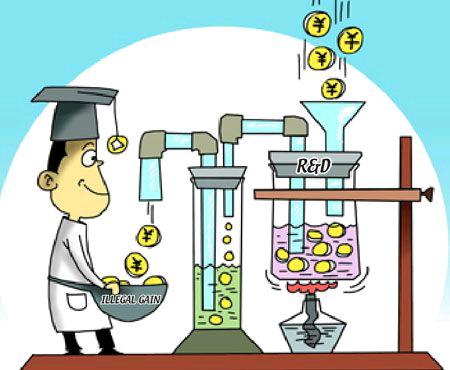Research Funding Overhaul
2015-02-28ByTangYuankai
By+Tang+Yuankai
An overhaul of Chinas scientific funding system has been initiated with the State Council issuing a reform plan in January.
The document, jointly drafted by the Ministry of Science and Technology (MOST) and the Ministry of Finance (MOF), aims to solve chronic problems regarding the allocation of financing for research and development programs so as to push forward other reform initiatives affecting science and technology.
The reform will strengthen coordination between concerned government departments, as well as endorse result-oriented and centralized management, according to Huai Jinpeng, President of Beihang University in Beijing. Huai said the new rules will effectively channel research funding to national priority projects, make R&D projects more compatible with the development of industry chains, and set up transparent evaluation systems.
Since early 2013, Huai has attended nearly 10 seminars to discuss the reform plan until it was published. “This reform is a shakeup of science and technology management. It will profoundly change the traditional model,” he said.
Integrated management
The State Councils reform plan said that by 2017, all existing national R&D programs will be integrated, including Program 863 for hitech development, Program 973 for basic research, the National Science and Technology Infrastructure Program, as well as research programs administered by Central Government departments such as the National Development and Reform Commission and the Ministry of Industry and Information Technology.
The reform aims to reorganize R&D programs managed by various government departments through industry and innova- tion chains,” said Lu Wei, Director of the Department of Techno-Economic Research under the Development Research Center of the State Council. Ultimately, this means the government is going to support the research, development, demonstration and deployment of demand-oriented programs.
Since the beginning of the 1980s, the Chinese Government has launched many R&D programs to keep abreast of the latest developments in science and technology and facilitate the application of research results in production processes. Some special programs crucial to economic development and national security have also been implemented.
Official statistics show that in 2013, fiscal expenditure on science and technology exceeded 500 billion yuan ($80 billion); while in contrast, that expenditure in 1978 was a little more than 5.2 billion yuan ($829 million), representing a nearly 100-fold growth.
Chinas total investment in R&D programs in 2013 exceeded 1.18 trillion yuan($189 billion), up 15 percent from the previous year, according to data released in October 2014 jointly by the National Bureau of Statistics, the MOST, and the MOF. In that year, research and development expenditure accounted for a record high of 2.08 percent of the national GDP.
Major science and technology programs have given birth to some of Chinas greatest scientific and technological achievements in recent years, such as high-performance computing, manned space flights and lunar exploration missions, development of the countrys first manned deep-sea research submersible and high-yield hybrid rice breeding.
But huge increases in research funding have not been matched with a proportional increase in world-class research results and scientists.
In the past 30 years or so, these science and technology programs have been administered by various government departments. According to Beijing-based Outlook magazine, more than 30 government departments have managed about 100 science and technology programs.
Under this arrangement, for one project, a researcher can apply for funding from multiple departments, leading to overlapping and hence inefficient use of government funds.
It has also given rise to power-money deals and abuse of funding. Such cases involve officials in charge of fund allocation, professors, academicians and other researchers. For instance, in October 2014, the MOST revealed that seven professors in five universities were investigated for obtaining more than 25 million yuan ($4 million) in research funds through deception.
Wan Gang, Minister of Science and Technology, admitted that as the 100 or so science and technology programs are scattered across scores of government departments, loopholes such as duplicated application, academic corruption and poor supervision exist.
“Many problems exist in research funding management, and two of the most prominent are fragmented management and lack of focus in science and technology programs,” said Zhang Xiaoyuan, Director of the Department of Facilities and Financial Support of the MOST.
According to Zhang, these problems suggest that the current management sys- tem and government departments roles be not compatible with the general trend in innovation and industrial revolution.
“The government should implement a growth-through-innovation strategy, and be resolute in transforming its own functions, streamlining itself and delegat- ing powers, and deepen reform in the management of science and technology programs,” Zhang said.
Carefully designed reform
For years, new science and technology programs have been simply piled on top of old ones, leading to overlapping funding.
Before the State Councils reform plan was launched, the MOST and the MOF made an in-depth analysis of salient problems in research funding management.
“We analyzed the nearly 100 government-sponsored R&D programs one by one to figure out what should be integrated and optimized,” said Zhao Lu, Director of the Education, Science, Technology and Culture Department of the MOF.
Zhao said that this reform will affect the allocation of more than half of the Central Governments science and technology budget.
Zhang Xianen, a researcher with the Institute of Biophysics, Chinese Academy of Sciences, took part in several discussions on the draft reform plan. He said that the research funding reform has responded to problems at three levels.
“It increases the efficiency of resource allocation at the national level, addresses the difficulty in coordination at the departmental level, and at the individual level, it saves researchersenergy and time dealing with the red tape of multiple regulatory agencies,” Zhang Xianen said. “The reform is extensive and has been rolled out faster than expected.”
The research funding reform will push forward other reform initiatives in science and technology, and create a favorable environment for implementing the development-through-innovation strategy, Wan commented.
On the other hand, recent developments in science and technology require us to think outside of the box and explore new research and development models, he added.
Changing government role
Complicated research funding systems lead to inefficiency. Chinese researchers on average spend 51 percent of their work time on research, and most of the remaining time on applying for funding, reported China Youth Daily.
Moreover, some researchers even fabricate research projects to win grants. The practice contravenes academic ethics and the purpose of fiscal funding.
Abuse of research funds and other related corruption cases has given rise to questioning about Chinas current research funding system.
In addition, research results still cannot meet national development needs. In particular, many important areas call for significant scientific and technological breakthroughs to remove development bottlenecks, Zhang Xiaoyuan said.
According to the State Councils reform plan, a cross-ministerial meeting coordinated by the MOST will deliberate on important matters, set procedural rules, review science and technology development strategies and key tasks, designate members of advisory and evaluation committees, and select professional agencies to handle funding applications.
Entrusting program management to professional agencies is a highlight of the reform.
The delegation of government departments power in managing science and technology programs marks a “real step forward” in the science and technology system reform, a researcher with the Chinese Academy of Sciences told Beijing Review.
By detaching itself from managing specific projects, the government can better perform its functions while letting the market play a decisive role in the allocation of resources, the researcher said.
“Of course, that does not mean that the government will stay out of everything. Rather, it will sign consignment agreements with professional agencies, and standardize project evaluation rules,”Zhang Xiaoyuan said. He added that the MOST and the MOF will regularly evaluate the performance of professional agencies, and set up a mechanism to hold them accountable retrospectively for their decisions. “These agencies will also be overseen by the general public,” he said.
In addition to existing science and technology management agencies such as the National Natural Science Foundation of China, more such professional agencies will be established in strict accordance with preset qualification requirements and they must be properly supervised, Zhao said.
“Professional agencies at different levels, of various types, and with multiple functions should be set up according to the characteristics of science and technology programs,” Lu said. She stressed that these agencies should not be only staffed with managerial personnel, but also with trained professionals such as scientists, engineers and business experts.
Another highlight of this reform is the establishment of a dynamic evaluation and adjustment system.
“Now much effective progress evaluation is required. If it is found that a project cannot reach the expected goal, it can be adjusted or even terminated,” Lu said.
